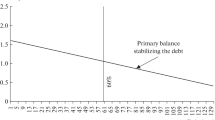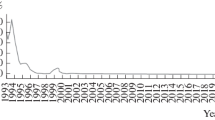Abstract
This chapter presents an overview of the main trends of Brazilian fiscal policy over the last decade, particularly for the period since the 2007–2008 Great Financial Crisis (GFC). It focuses on the changes in composition and orientation of fiscal policy during three sub-periods. The first was a sub-period characterised by fiscal expansion (2005–2010), whose fiscal space was channelled mainly towards public investment and redistributive transfers . It had an extraordinary economic performance. During the second sub-period (2011–2014), subsidies and tax cuts played a central role in the fiscal expansion. This new fiscal policy mix proved ineffective in preventing the economy from entering a downturn. The third sub-period (from 2015 onwards) is characterized by the shift to fiscal austerity , and by the worst recession ever recorded in the country’s history. Finally, it will discuss some of the challenges and socio-economic risks resulting from the recent and radical shift towards fiscal austerity.
Access this chapter
Tax calculation will be finalised at checkout
Purchases are for personal use only
Similar content being viewed by others
Notes
- 1.
Orair (2015) presents a description of these tax cuts and analysis of the paradox of tax burden´s stability under a preponderance of tax cuts.
- 2.
In 2014, the minimum wage value (BRL724 per month, or roughly USD268) was paid to nearly 25 million beneficiaries of social benefits.
- 3.
Chapter “New Features of the Brazilian External Sector since the Great Global Crisis” of this book provides a deeper discussion and relevant analysis of the external sector.
- 4.
- 5.
The indicators of poverty and inequality, based on household surveys, have shown a decreasing tendency over the decade 2005-2014, due to the higher growth of income at the bottom of the income distribution, as demonstrated by Ipea (2015). However, recent studies, such as Medeiros et al. (2015), based on tax data, which captures more accurately the income of the richest in terms of the income distribution, show that top income concentration has changed little since 2006.
- 6.
During the electoral debate, the opposition defended the austerity thesis and the government defended the country’s fiscal situation, the success of its economic policy faced with a dire international scenario and the need for a mere ‘fine tuning’ of fiscal policy, which would not compromise the legacy of PT administrations. For a deeper analysis of the period, see Levy (2014) that provides a good example of the conventional narrative and Barbosa (2013) for the official one.
- 7.
See Jayadev and Konczal (2010), Guajardo et al. (2011) and Perotti (2011) for a criticism of the ‘austerity myth’. Recently, Alesina et al. (2017) recognised that fiscal consolidations have recessionary short-term effects, which might be mitigated depending on the profile and persistence of fiscal adjustments.
- 8.
Ireland in 1987 was the only reported case of a country in a soft recession before fiscal consolidation (−0,5% GDP growth) that has regained growth, driven mainly by exports.
- 9.
- 10.
According to Hanni et al. (2015) the redistributive impact of the fiscal policy in Brazil is the highest among Latin American countries, reducing the Gini coefficient in 7.1 percentage points mainly due to the effect of public transfers.
References
Alesina, A., Barbiero, O., Favero, C., Giavazzi, F., & Paradisi, M. (2017). The effects of fiscal consolidations: Theory and evidence (NBER Working Paper No. 23385). Cambridge: NBER.
Appy, B., Lisboa, M., Mendes, M., & Lazzarini, S. (2015). A Rigidez do Gasto Público: Problemas e Soluções. Interesse Nacional, 8(31).
Barbosa, N. (2013). Dez anos de política econômica. In E. Sader (Ed.), 10 anos de governos pós-neoliberais no Brasil: Lula e Dilma. Boitempo: São Paulo.
Barbosa Filho, F. H., & Pessoa, S. P. (2014). Desaceleração recente da economia”, In CDPP (Ed.) Coletânea de capítulos da agenda Sob a Luz do Sol. São Paulo: Centro de Debates de Políticas Públicas.
Dellepiane-Avellaneda, S. (2015). The political power of economic ideas: The case of ‘Expansionary Fiscal Contractions’. The British Journal of Politics & International Relations, 17(3), 391–418.
Giambiagi, F. (2008). 18 anos de política fiscal no Brasil: 1991/2008. Economia aplicada, 12(4), 535–580.
Gobetti, S. W., & Schettini, B. (2010). Dívida Líquida e Dívida Bruta: uma abordagem integrada para analisar a trajetória eo custo do endividamento brasileiro. Texto para Discussão, 1514. Brasília: Ipea.
Gobetti, S. W. (2014). Regras fiscais no Brasil e na Europa: um estudo comparativo e propositivo. Texto para Discussão, n. 2018. Rio de Janeiro: Ipea.
Gobetti, S. W., & Orair, R. O. (2015). Política fiscal em perspectiva: o ciclo de 16 anos (1999–2014). Revista de Economia Contemporânea, 19(3), 417–447.
Gobetti, S. W., & Orair, R. O. (2017). Resultado Primário e Contabilidade Criativa: reconstruindo as estatísticas fiscais ‘acima da linha’ do governo geral. Texto para Discussão, n. 2288. Brasília: Ipea.
Guajardo, J., Leigh, D., & Pescatori, A. (2011). Expansionary Austerity: New International Evidence (IMF Working Paper 11/158). Washington, DC: Interrnational Monetary Fund.
Hanni, R., Martner, M., & Podestá, A. (2015). El potencial redistributivo de la fiscalidad en América Latina. Revista Cepal, 116, August, 7–26.
IMF. (2016). World Economic Outlook Database, October. Available at https://www.imf.org/external/pubs/ft/weo/2016/02/weodata/index.aspx.
IPEA. (2015). PNAD 2014: Breves análises. Nota Técnica, 22. Brasília: Ipea.
Jayadev, A., & Konczal, M. (2010). The boom not the slump: The right time for austerity. University of Massachusetts Boston Economics Faculty Publication Series. Paper 26
Kalecki, M. (1943). Political aspects of full employment. The Political Quarterly, 14(4), 322–330.
Levy, J. V. F. (2014). Robustez fiscal e qualidade do gasto como ferramentas para o crescimento. In CDPP (Ed.), Coletânea de capítulos da agenda Sob a Luz do Sol. São Paulo: Centro de Debates de Políticas Públicas.
Medeiros, M., Souza, P. H., & Castro, F. A. (2015). O Topo da Distribuição de Renda no Brasil: primeiras estimativas com dados tributários e comparação com pesquisas domiciliares (2006–2012). Dados—Revista de Ciências Sociais, 58(1), 7–36.
Mesquita, M. (2014). A política econômica do governo Dilma: a volta do experimentalismo, In CDPP (Ed.), Coletânea de capítulos da agenda Sob a Luz do Sol. São Paulo: Centro de Debates de Políticas Públicas.
MF. (2015). Reequilíbrio Fiscal e Retomada da Economia. Brasília: Ministério da Fazenda. Brasília: Ministério da Fazenda.
Nóbrega, M. (2016). Construção e Desmonte das Instituições Fiscais. In F. Salto & M. Almeida (Eds.), Finanças Públicas: da contabilidade criativa ao resgate da credibilidade. Rio de Janeiro: Record.
Orair, R. O. (2015). Desonerações em alta com rigidez da carga tributária: o que explica o paradoxo do decênio 2005–2014? Texto para Discussão, n. 2117. Brasília: Ipea.
Orair, R. O. (2016). Investimento Público no Brasil: trajetória e relações com o regime fiscal. Texto para Discussão, n. 2215. Brasília: Ipea.
Orair, R. O., Gobetti, S. W., & Siqueira, F. F. (2016). Política Fiscal e Ciclo Econômico: uma análise baseada em multiplicadores de gasto público. In STN—Secretaria Do Tesouro Nacional. XXI Prêmio Tesouro Nacional de Monografias. Brasília: STN.
Paula, L. F., Modenesi, A. M., & Pires, M. C. (2015). The tale of the contagion of two crises and policy responses in Brazil: A case of (Keynesian) policy coordination? Journal of Post Keynesian Economics, 37(3), 408–435.
Pellegrini, J. A. (2011). Dívida Bruta e Ativo do Setor Público: o que a queda da dívida líquida não mostra? Texto para Discussão, n. 95. Brasília: Núcleo de Estudos e Pesquisas do Senado.
Perotti, R. (2011). The ‘austerity myth’: Gain without pain? (NBER Working Paper 17571). Cambridge: NBER.
Rezende, F., Oliveira, F., & Araújo, E. (2007). O dilema fiscal: remendar ou reformar? Rio de Janeiro: FGV Editora.
Schaechter, A., Kinda, T., Budina, N., & Weber, A. (2012). Fiscal rules in response to the crisis—toward the ‘Next Generation’ rules: A new dataset (IFM Working Paper 12/187). Washington, DC: International Monetary Fund.
Schettini, B. P., Gouvea, R. R., Orair, R., & Gobetti, S. W. (2011). Resultado Estrutural e Impulso Fiscal: uma aplicação para as administrações públicas no Brasil—1997–2010. Pesquisa e Planejamento Econômico, 41, 233–285.
Serrano, F., & Summa, R. (2016). Aggregate demand and the slowdown of Brazilian economic growth in 2011–2014. Nova Economia, 25(special issue), 803–833.
Singer, A. (2015). Cutucando onças com varas curtas O ensaio desenvolvimentista no primeiro mandato de Dilma Rousseff (2011–2014). Novos Estudos, 102, 43–71.
Author information
Authors and Affiliations
Corresponding author
Editor information
Editors and Affiliations
Rights and permissions
Copyright information
© 2017 The Author(s)
About this chapter
Cite this chapter
Orair, R.O., Gobetti, S.W. (2017). Brazilian Fiscal Policy in Perspective: From Expansion to Austerity. In: Arestis, P., Troncoso Baltar, C., Prates, D. (eds) The Brazilian Economy since the Great Financial Crisis of 2007/2008. Palgrave Macmillan, Cham. https://doi.org/10.1007/978-3-319-64885-9_9
Download citation
DOI: https://doi.org/10.1007/978-3-319-64885-9_9
Published:
Publisher Name: Palgrave Macmillan, Cham
Print ISBN: 978-3-319-64884-2
Online ISBN: 978-3-319-64885-9
eBook Packages: Economics and FinanceEconomics and Finance (R0)




